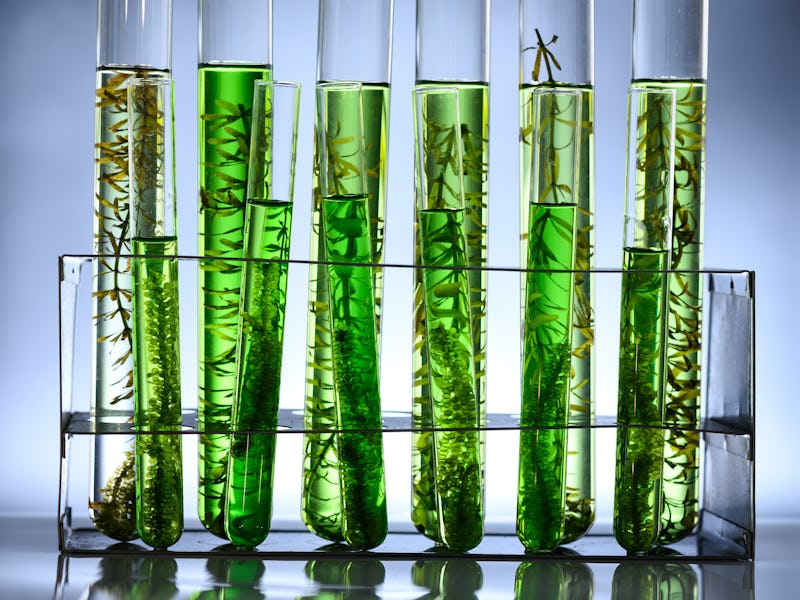Turbo-boosted photosynthesis could mean cars running on algae
This super-charged plant life may just one day power your road trips.

Plants are rockstars when it comes to creating their own sustainable energy with just three simple ingredients — water, CO2, and sunlight — but scientists now have a plan to turbo-charge this fundamental biological process.
By introducing special light-harvesting polymers to algae, researchers may be able to significantly boost its photosynthesis output, and in particular the creation of fatty lipids and proteins.
The extra lipid and protein production could in turn transform algae into a super biofuel source, offering another way to move past our reliance on fossil fuels.
In the new study, published Wednesday in the journal Science Advances, the researchers explain that while algae have intrinsic potential as a biofuel source, it has struggled to meet its potential.
"Photosynthetic algae are not only primary producers in the ecological system but also economically valuable as a potential source of biofuel," write the authors. " However, inefficient solar-to-biofuel conversion of algae has primarily impeded the commercialization of the biofuel."
Optimizing the photosynthetic efficiency of these "microscopic synthetic factories" opens the door to a higher yield of biofuel from organisms like algae, argue the authors. Other studies have proposed designing entirely artificial leaves to create biofuel, or amping up natural photosynthesis using photosynthetic dyes or carbon nanotubes. But this study focuses instead on tweaking an internal mechanism that controls how plants react to different wavelengths of light.
In theory, optimizing this mechanism could automatically improve the way the plant does photosynthesis.
The authors write that this kind of "artificial regulation" is "a smart and promising way to improve efficiency of natural photosynthesis."
In addition to testing out their polymer on algae, the team also looked at how a flowering plant would react to it and found, at low doses, it accelerated growth.
How did they do it — To tweak the plants' natural abilities, the researchers first had to dose their algae samples with a synthetic, light-harvesting polymer, called poly(boron-dipyrromethene-co-fluorene), or PBF for short. This polymer cocktail was stuck to C. pyrenoidosa algal cells in different concentrations using electrostatic interactions to see how the algae would react to different levels of the polymer.
In a subsequent test, the researchers also dosed a small, flowering plant called Arabidopsis thaliana with different concentrations of polymers to its roots.
What happened next — For the algae, the researchers observed accelerated photosynthesis and a 110 percent increase in overall plant growth. In addition to the elevated levels of ATP and oxygen created through this process, the algae also increased lipid and protein production -- key ingredients for biofuel.
As for the flower, high doses of the polymer appeared to cause stunted growth, but low doses of PBF resulted in faster growth and earlier flowering. This early flowering put the plant a full week ahead of its counterparts in terms of typical growth.
The future of fossil fuels? — When it comes to the future of fuel, biofuel offers both a more sustainable solution that can be used in existing energy infrastructure. But despite the promise it is not yet feasible to directly fuel-up your car with plant-based energy.
Super-charged algae like this would be joining the biofuel ranks with materials like discarded PPE, thrown-out kitchen grease, and even nail-polish remover.
The researchers don't expand on how algae-based biofuel would perform in comparison to these other alternative sources, but this preliminary success may be a step toward a future where biofuel alternatives are lined up at the gas pump like soda dispensers.
Abstract: Artificial regulation of state transition between photosystem I (PSI) and PSII will be a smart and promising way to improve efficiency of natural photosynthesis. In this work, we found that a synthetic light-harvesting polymer [poly(boron-dipyrromethene-co-fluorene) (PBF)] with green light absorption and far-red emission could improve PSI activity of algae Chlorella pyrenoidosa, followed by further upgrading PSII activity to augment natural photosynthesis. For light-dependent reactions, PBF accelerated photosynthetic electron transfer, and the productions of oxygen, ATP and NADPH were increased by 120, 97, and 76%, respectively. For light-independent reactions, the RuBisCO activity was enhanced by 1.5-fold, while the expression levels of rbcL encoding RuBisCO and prk encoding phosphoribulokinase were up-regulated by 2.6 and 1.5-fold, respectively. Furthermore, PBF could be absorbed by the Arabidopsis thaliana to speed up cell mitosis and enhance photosynthesis. By improving the efficiency of natural photosynthesis, synthetic light-harvesting polymer materials show promising potential applications for biofuel production.
This article was originally published on